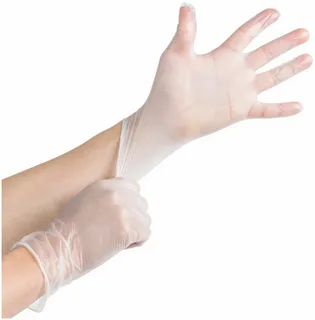The Environmental Impact of Vinyl Powder Free Gloves

Vinyl Powder Free Gloves have become common in various industries, from healthcare to food service. They are lightweight, affordable, and convenient. However, beneath their practicality lies an often-overlooked concern: the environmental impact of these seemingly harmless items. As we increasingly prioritize sustainable practices daily, it's crucial to understand how Vinyl-Gloves contribute to pollution and waste. This blog post delves into the production process of Vinyl-Gloves, disposal challenges, and their effects on wildlife and ecosystems. It also highlights eco-friendly alternatives that can help us reduce our ecological footprint while maintaining safety standards.
What Are Vinyl Powder-Free Gloves?
Vinyl powder-free gloves are popular in various industries, including healthcare and food service. Made from polyvinyl chloride (PVC), these gloves offer an affordable option for those seeking protection without compromising comfort. Their powder-free nature makes them suitable for individuals with latex allergies, reducing the risk of skin irritation.
These gloves provide a barrier against contaminants while allowing for decent tactile sensitivity. Although they may not be as durable as nitrile or latex options, their lightweight design is ideal for tasks that require frequent glove changes or shorter wear times.
Vinyl powder-free gloves come in various sizes and thicknesses to cater to different needs. While they excel in specific applications, awareness of their environmental impact has sparked discussions about more sustainable alternatives in recent years.
The Production Process and Its Environmental Footprint
The production of vinyl powder-free gloves begins with the extraction of petrochemicals. These raw materials undergo chemical processes to create the primary component of polyvinyl chloride (PVC). This process is energy-intensive and contributes significantly to greenhouse gas emissions, raising concerns about environmental sustainability.
Additionally, manufacturing sites often consume large amounts of water and generate hazardous waste. If not properly managed, effluents from these facilities can contaminate local waterways. The potential for pollution raises alarms among environmental advocates, who emphasize the need for cleaner production methods.
Moreover, transporting these gloves adds another layer to their carbon footprint. Every mile travelled impacts air quality and climate change from factories to distribution centres. As awareness grows around sustainable practices, industries are urged to seek greener alternatives in glove production while minimizing harm to our planet's ecosystems.
Disposing of Vinyl Gloves and Waste Management Challenges
Disposing of Vinyl Gloves presents significant challenges for waste management systems. Many facilities treat these gloves as general waste but are not biodegradable. This means they can persist in landfills for hundreds of years, contributing to environmental pollution.
Improper disposal methods often increase plastic waste in oceans and natural habitats. Accumulating synthetic materials poses risks to wildlife that may ingest or become entangled in debris. As such, the impact extends beyond human health concerns.
Recycling options remain limited due to contamination issues and the specific materials used in production. Without proper infrastructure for recycling Vinyl-Gloves, many are discarded without consideration for their long-term effects on the environment. Addressing these challenges requires a multi-faceted approach from both industries and consumers.
Impact on Wildlife and Ecosystems
The impact of vinyl powder-free gloves on wildlife and ecosystems is often overlooked. When these gloves are discarded improperly, they can end up in oceans, rivers, and natural habitats. Marine life is particularly vulnerable; animals may mistake the plastic for food, leading to ingestion that can cause severe harm or death.
Additionally, when Vinyl-Gloves break down in the environment, they release harmful chemicals. These toxins can leach into soil and water systems, affecting plants and other organisms. This chemical runoff disrupts local ecosystems and poses long-term threats to biodiversity.
Wildlife faces increasing challenges as human waste continues to accumulate. Birds might become entangled in discarded gloves while aquatic creatures succumb to pollution from breakdown materials. The ripple effect on food chains highlights how one seemingly small item contributes significantly to broader environmental issues.
Benefits of Eco-Friendly Glove Options
Choosing eco-friendly gloves offers numerous advantages for both the environment and your well-being. Here are some key benefits:
Reduced Landfill Waste
Biodegradable and compostable glove options break down naturally, minimizing the volume of waste accumulating in landfills. This helps conserve valuable space and reduces the long-term environmental burden.
Lower Carbon Footprint
Eco-friendly gloves often utilize sustainable materials and manufacturing processes, resulting in a lower carbon footprint than traditional Vinyl-Gloves. This contributes to mitigating climate change.
Decreased Chemical Exposure
Many eco-friendly gloves are made without harmful chemicals or additives, reducing users' risk of skin irritation and allergies. They also prevent the release of these chemicals into the environment during production and disposal.
Conservation of Resources
Sustainable glove production often relies on renewable resources and minimizes the consumption of finite resources, such as petroleum, used in vinyl glove manufacturing.
Enhanced Brand Image
By choosing eco-friendly gloves, businesses and individuals demonstrate their commitment to sustainability, enhancing their brand image and appealing to environmentally conscious consumers.
The Role of Recycling in Reducing Vinyl Glove Waste
Recycling is crucial in addressing the waste generated by vinyl powder-free gloves. These disposable items often end up in landfills, which can take decades to decompose. By recycling them, we can significantly reduce this environmental burden.
Specialized facilities are now emerging that focus on recycling medical and industrial plastic waste, including Vinyl-Gloves. The process involves breaking down the material and repurposing it into new products. This not only conserves resources but also minimizes the need for virgin materials.
Moreover, promoting awareness about recycling options encourages more businesses to participate actively in sustainable practices. When organizations prioritize proper disposal methods and partner with recyclers, they contribute positively to their communities while reducing their carbon footprint. Engaging in these efforts is vital for creating a cleaner environment.
Alternatives to Disposable Vinyl Gloves
As awareness of environmental issues grows, many seek alternatives to Disposable Vinyl Gloves. One popular option is nitrile gloves. Made from synthetic rubber, they offer excellent durability and puncture resistance while being latex-free, making them suitable for those with allergies.
Another eco-friendly choice is biodegradable gloves made from cornstarch or natural rubber. Compared to traditional vinyl options, these gloves break down more quickly in landfills, reducing the long-term impact on our planet.
Reusable gloves also present a sustainable solution. Often crafted from thick latex or silicone, they can be cleaned and used multiple times without sacrificing safety or protection. This cuts down on waste and saves money in the long run, as fewer products need to be purchased repeatedly.
Government Regulations and Industry Standards
Government regulations play a crucial role in managing the production and disposal of vinyl powder-free gloves. Various agencies, such as the Environmental Protection Agency (EPA), set guidelines to ensure manufacturers adhere to environmental standards. These regulations aim to minimize harmful emissions during production and promote safer waste management practices.
Industry standards are also essential for establishing best practices among manufacturers. Organizations like ASTM International provide specifications that help ensure quality while considering environmental impacts. Compliance with these standards is vital for companies aiming to reduce their ecological footprint.
Moreover, regulatory bodies encourage innovation within the industry. Promoting eco-friendly alternatives and sustainable materials pushes manufacturers toward greener solutions without sacrificing functionality or safety. This shift benefits consumers and supports efforts to protect our planet's ecosystems.
Conclusion
Choosing Vinyl Powder Free Gloves has implications that extend beyond personal or workplace safety. The environmental footprint of these gloves is significant, affecting ecosystems and wildlife. Awareness of their impact encourages more responsible choices. Exploring alternatives to vinyl can lead individuals and businesses toward sustainable practices. Eco-friendly options not only reduce waste but also support a healthier planet. Investing in safe materials should be at the forefront of decision-making processes. As consumers become increasingly eco-conscious, the demand for greener solutions rises. This shift can influence manufacturers to innovate and create products with minimal environmental harm. Every choice counts when it comes to protecting our environment for future generations.
FAQs
The rise of vinyl powder-free gloves in various industries has raised important questions about their environmental impact. Here are five frequently asked questions that can help clarify some concerns.
What materials are used to make vinyl powder-free gloves?
Vinyl powder-free gloves are primarily made from polyvinyl chloride (PVC). While this inexpensive material offers good barrier protection, its production uses fossil fuels, contributing to carbon emissions.
Are Vinyl-Gloves recyclable?
Vinyl glove recycling options are limited due to contamination and the complexities involved in processing PVC. Some specialized programs exist, but they aren't widely available.
How should I dispose of used Vinyl Gloves?
Used Vinyl Gloves should ideally be disposed of as medical waste if contaminated. If they're clean, check local regulations, as some areas may allow them to be in regular trash; however, incineration or landfilling is often necessary in most cases.
Do eco-friendly alternatives perform as well as Vinyl-Gloves?
Eco-friendly glove options, such as those made from biodegradable materials or natural rubber latex, often provide comparable performance while reducing environmental impact. Depending on user preference, they might even offer better comfort and fit.
What regulatory measures exist regarding glove disposal?
Various regulations dictate how medical and hazardous waste, including disposable gloves, must be managed. Businesses must stay informed about local guidelines to ensure compliance while minimizing ecological harm.
|
Related Business Listings |






